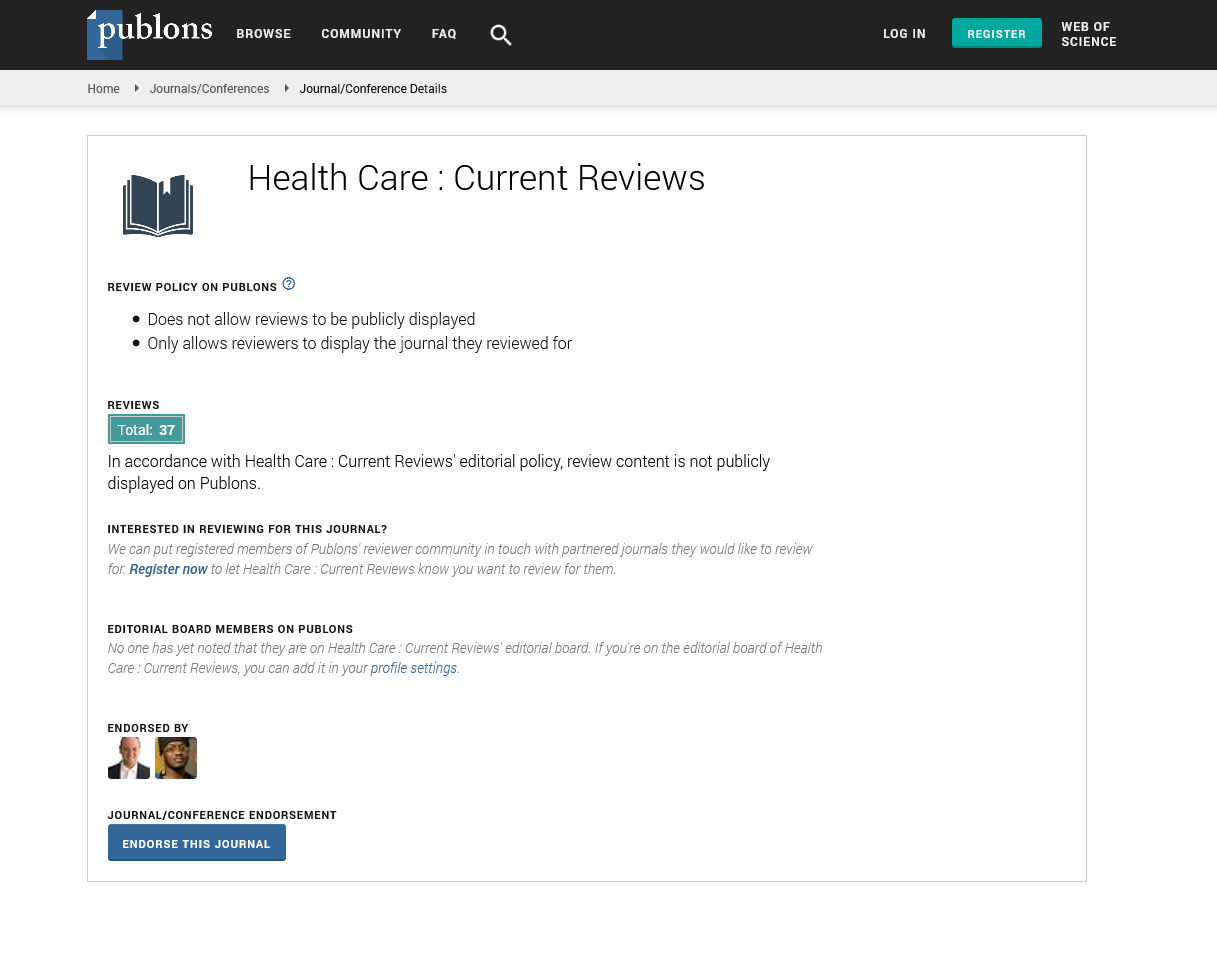PMC/PubMed Indexed Articles
Indexed In
- Open J Gate
- Academic Keys
- RefSeek
- Hamdard University
- EBSCO A-Z
- Publons
- Geneva Foundation for Medical Education and Research
- Google Scholar
Useful Links
Share This Page
Journal Flyer

Open Access Journals
- Agri and Aquaculture
- Biochemistry
- Bioinformatics & Systems Biology
- Business & Management
- Chemistry
- Clinical Sciences
- Engineering
- Food & Nutrition
- General Science
- Genetics & Molecular Biology
- Immunology & Microbiology
- Medical Sciences
- Neuroscience & Psychology
- Nursing & Health Care
- Pharmaceutical Sciences
Opinion Article - (2022) Volume 10, Issue 5
Digital Health Interventions for Quality Health Care
David Hook*Received: 02-May-2022, Manuscript No. HCCR-22-16947; Editor assigned: 05-May-2022, Pre QC No. HCCR-22-16947(PQ); Reviewed: 19-May-2022, QC No. HCCR-22-16947; Revised: 26-May-2022, Manuscript No. HCCR-22-16947(R); Published: 02-Jun-2022, DOI: 10.35248/2375-4273.22.10.294
Description
The identification of user needs, as well as the development and evaluation of any interactive digital health intervention, necessitates multidisciplinary competence in research and development. Health (broadly defined) and Human–Computer Interaction are two of the most important areas of knowledge. Despite the fact that they share similar research methodologies and ideals they have significant variances that can make multidisciplinary cooperation difficult resulting in sub-optimal project outcomes. The distinction between formative (emphasized in Human–Computer Interaction) evaluation is most commonly (emphasized in Health research). The variations however, go much beyond that, ranging from the form of acceptable evidence to reporting culture. The digital intervention and progressing through the many stages of development, evaluation, and implementation, all the way to reporting research findings.
Interest in ways to improve the mental health of children and adolescents with the support of Digital Health Interventions (DHI) as technical applications are seen as increasingly valuable for addressing healthcare delivery, especially access and maintenance issues. DHI for children and adolescents with mental illness. DHI studies focusing on anxiety, depression, eating disorders, and autism spectrum disorders. They noted the lack of reviews assessing the effectiveness of widespread DHI in adolescents. Innovative Health technology is described, including the medication compliance. A study by reported that less than half of children and adolescents (ages 4-17) are stimulant. Because children, adolescents, and parents are already broadly embracing the technology, the health application can be used to improve dosing uptake rates. Smartphone applications designed to improve medication Digital fitness technologies are available many distinct forms and amplify into numerous components of healthcare.
As new technology develops, virtual fitness, as a field, respectively transforms. The virtual fitness technology consists of telemedicine and digital reality. Telemedicine is how physicians deal with sufferers remotely and the distinct technology had to make the procedure faster. The usage of open-source software, mobile technologies and cloud-based data infrastructure may mitigate these issues. The implementation of new regulations and standards. These innovations' research and development must take into account the technological infrastructure and legal frameworks that control local technology uptake in order to achieve scalability and sustainability. The government has recognized the importance of digital health technologies in improving health care and streamlining administrative processes and the Ministry of Health (MoH) has issued new digital health policies and guidance in addition to building national health databases like the national Electronic Health Record (EHR) system. Knowledge about the government's present policies and plans for the future of digital health.
Almost often, interdisciplinary study raises issues of values, assumptions, terminology, technique, and culture. We focus on the obstacles of generating and successful interactive Digital Health Interventions (DHIs). Interactive DHIs are healthimprovement interventions offered through a digital platform. Human–computer interaction and software engineering and those originating in biomedical sciences and psychology are two important topics of study in interactive DHIs. Each of these areas of knowledge relies on a variety of disciplines. Digital health is a field that combines digital care programmers, technologies, and health, healthcare, life, and society to improve healthcare delivery efficiency and make medicine more individualized and accurate. It makes use of information and communication technology to make health problems and obstacles more understandable for persons receiving medical treatment and social prescribing more individualized and precise.
Citation: Hook D (2022) Digital Health Interventions for Quality Health Care. Health Care Curr Rev. 10:294.
Copyright: © 2022 Hook D. This is an open-access article distributed under the terms of the Creative Commons Attribution License, which permits unrestricted use, distribution, and reproduction in any medium, provided the original author and source are credited.

